Polish "relatives" of the Kalashnikov assault rifle
 It all began, as with many other countries, from the fact that Poland became one of the Warsaw Pact countries, and this meant that the cartridge of 7,62x39 became the main patron for the army of Poland. Since the Poles did not have a decent weapon for the given ammunition, and it was not possible to quickly launch production, the first time, namely from 1952 to 1958 a year, Kalashnikov assault rifles supplied the Soviet Union to Poland. So with the 1952 year, a weapon version was supplied to Poland only with a fixed butt under the designation RMK, and after 1957, the delivery of a weapon with a folding PMKS butt was established. Only in 1958, the production of a Kalashnikov assault rifle under license from the Soviet Union was established in Poland. It was then that the first Kalashnikov assault rifles of Polish origin appeared.
It all began, as with many other countries, from the fact that Poland became one of the Warsaw Pact countries, and this meant that the cartridge of 7,62x39 became the main patron for the army of Poland. Since the Poles did not have a decent weapon for the given ammunition, and it was not possible to quickly launch production, the first time, namely from 1952 to 1958 a year, Kalashnikov assault rifles supplied the Soviet Union to Poland. So with the 1952 year, a weapon version was supplied to Poland only with a fixed butt under the designation RMK, and after 1957, the delivery of a weapon with a folding PMKS butt was established. Only in 1958, the production of a Kalashnikov assault rifle under license from the Soviet Union was established in Poland. It was then that the first Kalashnikov assault rifles of Polish origin appeared.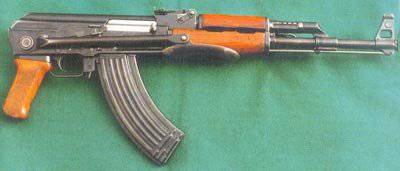 One of the oldest Lucznik arms factories in the city of Radom was engaged in the production of weapons. In addition, a machine-building plant in Poznan was involved. Despite the fact that the weapon was absolutely no different from the models supplied by the Soviet Union, the names of the machines were replaced and it must be said that the new names were more accurate and correct. So the option with a fixed butt got the name Kbk-AK, respectively, a weapon with a folding butt was designated as Kbk-AKS. These weapons were not exported and were used only domestically. The length of the machine with a fixed butt is 870 millimeters, the length of the weapon with a folding butt is equal to 878 and 645 millimeters for the folded and folded butt, respectively. The weight of a weapon with a fixed butt is equal to 3,87 kilogram, for the version of the machine with a folding butt 3,82 kilogram.
One of the oldest Lucznik arms factories in the city of Radom was engaged in the production of weapons. In addition, a machine-building plant in Poznan was involved. Despite the fact that the weapon was absolutely no different from the models supplied by the Soviet Union, the names of the machines were replaced and it must be said that the new names were more accurate and correct. So the option with a fixed butt got the name Kbk-AK, respectively, a weapon with a folding butt was designated as Kbk-AKS. These weapons were not exported and were used only domestically. The length of the machine with a fixed butt is 870 millimeters, the length of the weapon with a folding butt is equal to 878 and 645 millimeters for the folded and folded butt, respectively. The weight of a weapon with a fixed butt is equal to 3,87 kilogram, for the version of the machine with a folding butt 3,82 kilogram. The Poles quickly realized that they wondered about the miracle in the form of a license to manufacture and upgrade the Kalashnikov assault rifle. In addition to the fact that this weapon was excellent in itself, it also represented an endless base for new types of automata. But they decided to start small - the realization of the possibility to use over-caliber grenades in weapons. So 1959, the gunsmiths Khodkiewicz and Dvojak, presented their modification of the Kalashnikov assault rifle, who could pretty well “throw” grenades. Weapon got the name Kbkg wz. 60. The main difference between this machine gun and copies of the Soviet was that the weapon had the opportunity to turn off the discharge of powder gases from the barrel, thereby making weapons with manual reloading, which was the main point when using above-caliber grenades. The weapon was completed with a LON-1 grenade launcher. Weapons could use almost the entire range of shots from fragmentation to smoke, throwing from a distance from 100 to 200 meters, depending on the characteristics of the shot. Sights for firing weapons like a grenade launcher was a reclining bar with a glass level. A remarkable point in this weapon is that in order to reduce recoil when firing a grenade launcher, a rubber pad is put on the butt, which is fixed with leather straps by two metal fasteners on either side of the butt. When firing from a weapon like a grenade launcher, a separate magazine with an empty cartridge capacity in 10 is used. In addition to reducing the capacity of the store, it also differs from the original in that it has an insert that does not allow to charge it with combat ammunition. The length of the machine is equal to 1075 millimeters, its weight is equal to 4,65 kilogram.
The Poles quickly realized that they wondered about the miracle in the form of a license to manufacture and upgrade the Kalashnikov assault rifle. In addition to the fact that this weapon was excellent in itself, it also represented an endless base for new types of automata. But they decided to start small - the realization of the possibility to use over-caliber grenades in weapons. So 1959, the gunsmiths Khodkiewicz and Dvojak, presented their modification of the Kalashnikov assault rifle, who could pretty well “throw” grenades. Weapon got the name Kbkg wz. 60. The main difference between this machine gun and copies of the Soviet was that the weapon had the opportunity to turn off the discharge of powder gases from the barrel, thereby making weapons with manual reloading, which was the main point when using above-caliber grenades. The weapon was completed with a LON-1 grenade launcher. Weapons could use almost the entire range of shots from fragmentation to smoke, throwing from a distance from 100 to 200 meters, depending on the characteristics of the shot. Sights for firing weapons like a grenade launcher was a reclining bar with a glass level. A remarkable point in this weapon is that in order to reduce recoil when firing a grenade launcher, a rubber pad is put on the butt, which is fixed with leather straps by two metal fasteners on either side of the butt. When firing from a weapon like a grenade launcher, a separate magazine with an empty cartridge capacity in 10 is used. In addition to reducing the capacity of the store, it also differs from the original in that it has an insert that does not allow to charge it with combat ammunition. The length of the machine is equal to 1075 millimeters, its weight is equal to 4,65 kilogram.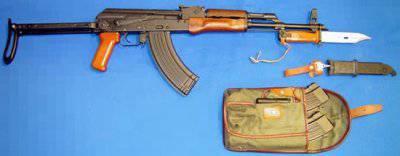
Despite the creation of this type of weapon, the Poles didn’t stop to get a production license from the Soviet Union again, this time the production of the Polish AKM was established. The weapon received the names Kbk-AKM and Kbk-AKMS for the machine with a fixed and folding butt, respectively. The length of the machine with a fixed butt was 870 millimeters, its weight was equal to 3,45 kilogram. The arms with a folding butt had a maximum length of 878 millimeters, and with a folded butt, its length was 645 millimeters. The weight of the machine was equal to 3,42 kilogram.
The design of the machine gun with the possibility of firing above-caliber grenades also did not stand still. So in 72, more sophisticated fragmentation grenades appeared, in connection with which the sights of weapons were reworked. The machine has received a new name Kbkg wz. 60 / 72, but did not receive the spread, as in its place came the barrel-mounted forty-mm rocket launcher. The length of the weapon remained the same and was equal to 1075 millimeters, but the weight increased to 4,85 kilogram. The machine gun was fed from all the same stores with a capacity of 30 and 10 cartridges, and began to rush grenades already at a distance of up to 240 meters.
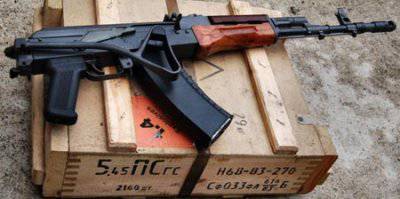 After the transition from the cartridge caliber 7,62 to the cartridge 5,45, Poland no longer received the license for the production of AK74 from the Soviet Union and decided to create its own machine gun. But how much is he completely Polish? Yes, his name does not even contain a mention of the Kalashnikov machine gun, however, it is only worth a glimpse of this machine gun and it immediately becomes clear that this is a real AK, or rather its modification. We are talking about the machine Tantal. In spite of the fact that this weapon cannot be called completely Polish, it is impossible to deny the fact that the Poles have worked thoroughly with it, and this has mainly benefited the machine gun.
After the transition from the cartridge caliber 7,62 to the cartridge 5,45, Poland no longer received the license for the production of AK74 from the Soviet Union and decided to create its own machine gun. But how much is he completely Polish? Yes, his name does not even contain a mention of the Kalashnikov machine gun, however, it is only worth a glimpse of this machine gun and it immediately becomes clear that this is a real AK, or rather its modification. We are talking about the machine Tantal. In spite of the fact that this weapon cannot be called completely Polish, it is impossible to deny the fact that the Poles have worked thoroughly with it, and this has mainly benefited the machine gun.Work on the weapon chambered for 5,45x39 were very long by any measure. Only in 1991, the wz.88 or simply Tantal began to enter service. The long term of work on the weapon is justified by the fact that in this model of the machine they tried to simultaneously combine both maximum compatibility with previous models, and the replacement of ammunition, as well as the introduction of new weapon capabilities. Work on this machine began in the 1980 year, the first sample appeared by the 1985 year. Even 6 years it took designers to eliminate all the flaws of weapons that were identified during the tests.
 The basis for the weapon was AK74, however, the Poles placed the main emphasis on making the weapon as interchangeable as possible with AKM. This was primarily a business case, since AKM was already produced in Poland, or rather its version in Polish. The Tantal submachine gun appeared thanks to Bogdan Spädsky, who was the head of this project. The most important feature of this weapon is that it has the ability to fire with a cutoff of three rounds. In the AK-shaped weapon, it was far from uncommon at that time, and many designers added the ability to cut off when shooting their weapons. Due to the fact that the weapon received another fire regime, it was necessary to remake the elements of weapon control. So in place of the usual switch fuse-translator of fire modes, only the fuse remained. The ability to choose to shoot single, three rounds or a queue reassigned to another control and even on the other side of the weapon. However, the location of the fire translator switch, although not quite familiar, is quite convenient for switching with the thumb of the right hand. In order for the weapon to retain the possibility of firing above-caliber grenades, the weapon received a flame arrester different from the Soviet model, however this was no longer so relevant, since by the time weapons were adopted the grenade launchers were widespread.
The basis for the weapon was AK74, however, the Poles placed the main emphasis on making the weapon as interchangeable as possible with AKM. This was primarily a business case, since AKM was already produced in Poland, or rather its version in Polish. The Tantal submachine gun appeared thanks to Bogdan Spädsky, who was the head of this project. The most important feature of this weapon is that it has the ability to fire with a cutoff of three rounds. In the AK-shaped weapon, it was far from uncommon at that time, and many designers added the ability to cut off when shooting their weapons. Due to the fact that the weapon received another fire regime, it was necessary to remake the elements of weapon control. So in place of the usual switch fuse-translator of fire modes, only the fuse remained. The ability to choose to shoot single, three rounds or a queue reassigned to another control and even on the other side of the weapon. However, the location of the fire translator switch, although not quite familiar, is quite convenient for switching with the thumb of the right hand. In order for the weapon to retain the possibility of firing above-caliber grenades, the weapon received a flame arrester different from the Soviet model, however this was no longer so relevant, since by the time weapons were adopted the grenade launchers were widespread.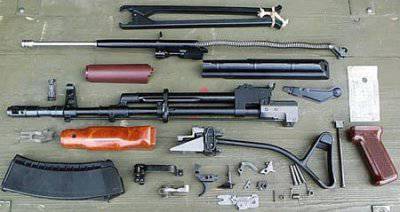 Interestingly, the transition to the 5,56 ammunition with 5,45 in Poland began to be prepared in the 1989 year, it was then that work began on the adaptation of the Tantal machine gun for the new ammunition. As a result, the new model was already ready for production of the 1990, but due to the fact that it still did not fit the requirements of the NATO standard, it did not leave the factory walls, remaining only an experienced weapon.
Interestingly, the transition to the 5,56 ammunition with 5,45 in Poland began to be prepared in the 1989 year, it was then that work began on the adaptation of the Tantal machine gun for the new ammunition. As a result, the new model was already ready for production of the 1990, but due to the fact that it still did not fit the requirements of the NATO standard, it did not leave the factory walls, remaining only an experienced weapon.The last of the Kalashnikov Polish machine guns chambered for the 5,45x39 had a length with the butt of a millimeter 943 unfolded, with the folded 748 of millimeters. The length of the barrel was 423 millimeters, and the weight of the machine was equal to 3,37 kilogram. This sample was distinguished by the rate of firing, which rose to 700 rounds per minute.
 Since Poland "flew" with the creation of weapons chambered for 5,56, then for some time used ammunition 5,45x39. At the same time, one full-size Tantal machine gun was clearly not enough to arm the army, so it was decided to complete work on creating another sample, which is a shortened version of the Tantal machine gun, under the name Onyks. Like all other similar samples, this machine is designed primarily for arming the crews of combat vehicles, airborne troops, special forces, police, and so on. One time, the shortening of the length of the barrel did not go off, and we had to reduce the entire structure, literally millimeters, for the sake of the overall result. An interesting point is that in the weapon the flame arrester allows the use of so-called rifle grenades, and more interestingly, in this sample they retained the possibility of firing with the cartridge's 3 cut-off, although, in my opinion, in this sample it is exactly an extra function.
Since Poland "flew" with the creation of weapons chambered for 5,56, then for some time used ammunition 5,45x39. At the same time, one full-size Tantal machine gun was clearly not enough to arm the army, so it was decided to complete work on creating another sample, which is a shortened version of the Tantal machine gun, under the name Onyks. Like all other similar samples, this machine is designed primarily for arming the crews of combat vehicles, airborne troops, special forces, police, and so on. One time, the shortening of the length of the barrel did not go off, and we had to reduce the entire structure, literally millimeters, for the sake of the overall result. An interesting point is that in the weapon the flame arrester allows the use of so-called rifle grenades, and more interestingly, in this sample they retained the possibility of firing with the cartridge's 3 cut-off, although, in my opinion, in this sample it is exactly an extra function.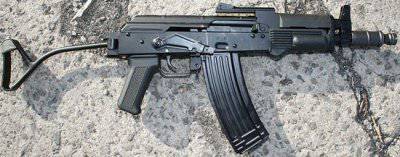 The sights of the submachine gun consist of a rear sight and a front sight, with the rear sight made flip and designed for firing distances of 100, 200 and 400 meters. The controls are arranged in almost the same way as in the Tantal machine.
The sights of the submachine gun consist of a rear sight and a front sight, with the rear sight made flip and designed for firing distances of 100, 200 and 400 meters. The controls are arranged in almost the same way as in the Tantal machine.In the same way as Tantal Onyks tried to adapt for 5,56 cartridge, and quite successfully, however, the machine itself did not meet NATO requirements, therefore, like Tantal in the version for 5,56 cartridges, it remained only experimental and was not mass-produced . Mass production of the Onyks was established only in 1993, and soon a new model of weapons appeared.
The mass of the Onyks machine is 2,9 kilograms. The length of its barrel is equal to the entire 207 millimeters, the total length with the butt unfolded 720 millimeters, with the folded 519 millimeters. The rate of fire equals 700 per minute.
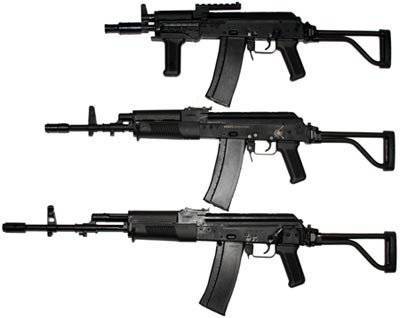 Despite the fact that Poland did not succeed in joining NATO at low cost, nobody abandoned this idea, and the modernization of the Tantal submachine gun under the new cartridge and the requirements of NATO began already in the 1994 year. As a result of this modernization, the entire 4 version of the weapon was produced under the name Beryl, but of course they did not appear simultaneously. The upgrade was carried out relatively quickly, and already in 1996, the weapon was completely ready. Despite the fact that Beryl’s external machine has a lot of differences from Tantal, it doesn’t fundamentally differ from it, but naturally, automaticity was recalculated and all elements related to changing ammunition from 5,45 to 5,56 were replaced. Since Tantal was once created on the basis of a Kalashnikov assault rifle, Beryl can also be considered a continuation of the development of this weapon, but in the Polish version.
Despite the fact that Poland did not succeed in joining NATO at low cost, nobody abandoned this idea, and the modernization of the Tantal submachine gun under the new cartridge and the requirements of NATO began already in the 1994 year. As a result of this modernization, the entire 4 version of the weapon was produced under the name Beryl, but of course they did not appear simultaneously. The upgrade was carried out relatively quickly, and already in 1996, the weapon was completely ready. Despite the fact that Beryl’s external machine has a lot of differences from Tantal, it doesn’t fundamentally differ from it, but naturally, automaticity was recalculated and all elements related to changing ammunition from 5,45 to 5,56 were replaced. Since Tantal was once created on the basis of a Kalashnikov assault rifle, Beryl can also be considered a continuation of the development of this weapon, but in the Polish version.The first versions of the machine became Beryl and Mini-Beryl. They differed from each other in barrel length and reduction in the length of the receiver, as well as the location of sights. So the length of the machine Beryl with the butt spread out was 943 millimeter, with the folded 742 millimeter. The length of the barrel of the weapon is 457 millimeters, and the weight of a kilogram 3,36 without cartridges. The machine feeds from detachable box stores with a capacity of 30 cartridges. The rate of fire is 700 shots per minute. The Mini-Beryl version of the weapon has a total length of millimeters with a folded 730 butt, with millimeters folded 525. The length of the weapon barrel is 235 millimeters, and the weight of the machine without ammunition is 3 kilogram. It feeds from shops with a capacity of 20 or 30 cartridges. The rate of fire is equal to 700 shots per minute. The difference in the lengths of the barrel machine guns significantly affected the speed of the bullet. So in the version of the weapon Beryl it is 920 meters per second, in the variant Mini-Beryl it is equal to 770 meters per second. With not the smallest dimensions of the machine with the Mini prefix and its weight, it is seriously inferior to the older fellow.
 After successfully passing the tests and correcting the small nuances in the weapon, the Beryl and Mini-Beryl submachine guns were put into service, this happened in the 1998 year. As in the Tantal machine gun, the lever, installed on the right side of the weapon, plays the role of a fuse switch; the fire mode interpreter is located on the left above the pistol grip and has three positions: “Automatic fire”, “Fire with cartridge cut-off on 3” and “Single fire” ". The barrel of the weapon was changed, the lid of which began to provide for the possibility of installing quick-detachable picatinny-type mounting strips for using various additional aiming devices. The weapon received a plastic forearm, on which three additional attachment strips can be mounted directly on top, for an additional handle of a laser pointer, a flashlight, and so on. The folding butt of the weapon very much resembles the same part of the Belgian FNC. In addition, the weapon can be equipped with folding removable bipods that simply put on the barrel of the machine when firing from a prone position, which significantly affects the accuracy of shooting, but the preparation of the weapon takes more time. It is also interesting that a bayonet was provided for this machine gun.
After successfully passing the tests and correcting the small nuances in the weapon, the Beryl and Mini-Beryl submachine guns were put into service, this happened in the 1998 year. As in the Tantal machine gun, the lever, installed on the right side of the weapon, plays the role of a fuse switch; the fire mode interpreter is located on the left above the pistol grip and has three positions: “Automatic fire”, “Fire with cartridge cut-off on 3” and “Single fire” ". The barrel of the weapon was changed, the lid of which began to provide for the possibility of installing quick-detachable picatinny-type mounting strips for using various additional aiming devices. The weapon received a plastic forearm, on which three additional attachment strips can be mounted directly on top, for an additional handle of a laser pointer, a flashlight, and so on. The folding butt of the weapon very much resembles the same part of the Belgian FNC. In addition, the weapon can be equipped with folding removable bipods that simply put on the barrel of the machine when firing from a prone position, which significantly affects the accuracy of shooting, but the preparation of the weapon takes more time. It is also interesting that a bayonet was provided for this machine gun.In addition to the two variants of the automaton described above, there is also a third one, which occupies an intermediate position between the two extremes. This is a variant under the name Beryl Commando. Its length with the butt spread out is 895 millimeters, with the folded 690, with the barrel length 357 millimeters. The weight of the machine without cartridges is 3,2 kilogram. The initial speed of the bullet is 870 meters per second. There is also a civilian version of the weapon under the name Beryl IPSC. It is made completely by analogy with a full-fledged Beryl, but is deprived of the possibility of firing with a cutoff of three rounds, as well as automatic fire, in all other parameters it completely repeats its combat progenitor, perhaps a little heavier - 3,5 kilogram.
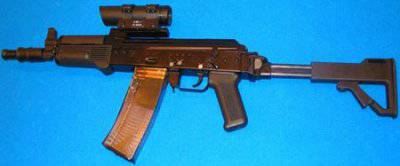 But after the establishment of production weapons did not cease to develop. So based on the feedback from those who participated in operations in Kosovo, Afghanistan and Iraq, it was proposed to change something in arms. The changes were not the most significant, but still had some benefit. So, for example, the weapon had a butt, which was regulated by its length, although it had only three positions, which, however, was easily corrected with skillful hands and a drill. In addition to the butt, it was proposed to use transparent magazines to control the quantities of the remaining cartridges, as well as to equip the weapon with a folding front sight, which was done in all versions of the weapon except the Beryl-Mini model.
But after the establishment of production weapons did not cease to develop. So based on the feedback from those who participated in operations in Kosovo, Afghanistan and Iraq, it was proposed to change something in arms. The changes were not the most significant, but still had some benefit. So, for example, the weapon had a butt, which was regulated by its length, although it had only three positions, which, however, was easily corrected with skillful hands and a drill. In addition to the butt, it was proposed to use transparent magazines to control the quantities of the remaining cartridges, as well as to equip the weapon with a folding front sight, which was done in all versions of the weapon except the Beryl-Mini model.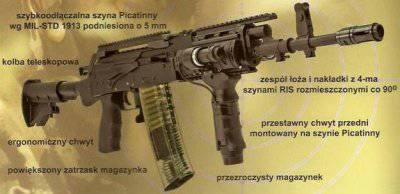 But the development of weapons did not stop there either. In the 2007 year, options were offered with a telescopic butt similar to that on the M4. In addition to the butt, the weapon also received a new transparent magazine of a more durable construction, as well as a shank, this time already made with built-in picatinny-type attachment plates. An interesting point is that in the set of weapons now there is an additional handle that is installed at the bottom of the mounting bar. So the weapon took on features that combined the characteristic features of the AK and the features of the M4.
But the development of weapons did not stop there either. In the 2007 year, options were offered with a telescopic butt similar to that on the M4. In addition to the butt, the weapon also received a new transparent magazine of a more durable construction, as well as a shank, this time already made with built-in picatinny-type attachment plates. An interesting point is that in the set of weapons now there is an additional handle that is installed at the bottom of the mounting bar. So the weapon took on features that combined the characteristic features of the AK and the features of the M4.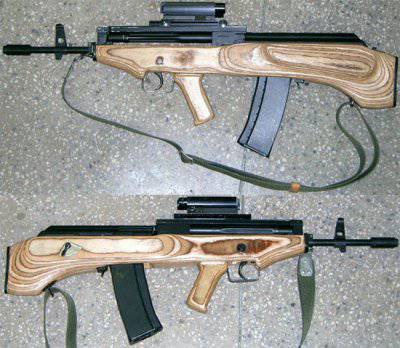 But this is not the end. story Kalashnikov assault rifle in Poland. Being very much modified in the version of Beryl, he has changed even more in the new weapon - the Jantar machine gun. A new machine gun appeared as part of an experiment, the purpose of which was to create weapons in the bullpup layout and to consider the possibility of using such a machine gun everywhere. Developed on the basis of Beryl Jantar, with special attention to ensure that the weapon was the most compatible with the old machine. Supervised the development of Michael Binek.
But this is not the end. story Kalashnikov assault rifle in Poland. Being very much modified in the version of Beryl, he has changed even more in the new weapon - the Jantar machine gun. A new machine gun appeared as part of an experiment, the purpose of which was to create weapons in the bullpup layout and to consider the possibility of using such a machine gun everywhere. Developed on the basis of Beryl Jantar, with special attention to ensure that the weapon was the most compatible with the old machine. Supervised the development of Michael Binek.The first version of the weapon appeared in the 2002 year, and was still an unfinished sample that could still shoot and the main characteristics of the new weapon were laid in it. This sample was designated as a BIN. The weapon was very specific, mainly because of its appearance, but you should not find fault with the first shooting sample. The machine gun proved to be much superior in accuracy than Beryl, while more compact dimensions were noted separately, although the designer made the weapon somewhat longer to reduce the amount of negative feedback about the inconvenience of recharging, close ejection of the sleeve near the shooter’s face, and so on. Despite the constructor’s efforts, negative feedback was present anyway, they concerned the inconvenient positioning of the fuse / translator fire switch, weapon balancing, and so on, in short, the shortcomings were noted almost the same as in all bullpup layouts. But the weapon received "good" for further development, the result of which did not take long to wait.
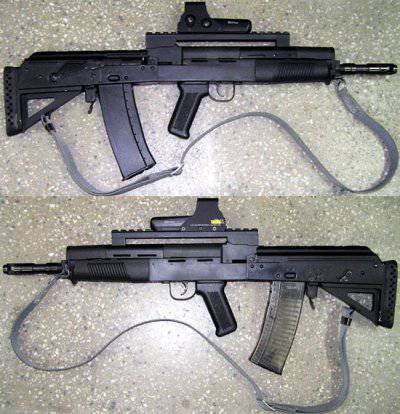 In 2005, the first Jantar appeared, the weapon had a length of 743 millimeter with a barrel length of 457 millimeters. His weight was 3,8 kilogram. Ate from the automatic detachment shops capacity 30 cartridges 5,56x45. The bullet speed was 920 meters per second, the 700 firing rate per minute. The weapon did not manage to get rid of its main drawback, which is not the most convenient arrangement of controls, but this time they were at least made similar to the Beryl machine gun. So on the right side of the machine, there was a large fuse switch, and on the left there was a translator of fire modes, which, like the Beryl machine gun, had three: “Automatic fire”, “Fire with a cartridge cut-off on 3”, “Single fire”. Interestingly, the submachine gun did not have its sighting devices, instead of them, a picatinny-type mounting bracket was installed on top of the weapon, on which the sighting devices were attached.
In 2005, the first Jantar appeared, the weapon had a length of 743 millimeter with a barrel length of 457 millimeters. His weight was 3,8 kilogram. Ate from the automatic detachment shops capacity 30 cartridges 5,56x45. The bullet speed was 920 meters per second, the 700 firing rate per minute. The weapon did not manage to get rid of its main drawback, which is not the most convenient arrangement of controls, but this time they were at least made similar to the Beryl machine gun. So on the right side of the machine, there was a large fuse switch, and on the left there was a translator of fire modes, which, like the Beryl machine gun, had three: “Automatic fire”, “Fire with a cartridge cut-off on 3”, “Single fire”. Interestingly, the submachine gun did not have its sighting devices, instead of them, a picatinny-type mounting bracket was installed on top of the weapon, on which the sighting devices were attached.The project itself of this machine was not considered as a project to replace the Beryl machine or a project to create a new additional weapon; it was only an experiment to feel the advantages and disadvantages of the machine in the configuration of the bullpup at all stages of production, and after and as a result of this production. In other words, the main goal of this weapon was to show the main advantages of the Bullpup layout automata, to reveal their shortcomings, and also to give designers experience in designing such weapons. In short, the automatic did not become a weapon for the army.
These are interesting samples created on the basis of the Kalashnikov assault rifle, were developed in Poland. This weapon, in fact, is a separate branch of AK development, because personally these automata are most interesting to me, since you can see how other designers looked at this or that question. Well, how much better or worse a particular model, the AK model corresponding to her in time, each compares for itself separately.
Information